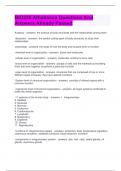Exam (elaborations)
BIO235 Athabasca Questions And Answers Already Passed
- Course
- Institution
BIO235 Athabasca Questions And Answers Already Passed Anatomy - answers the science of body structures and the relationships among them dissection - answers the careful cutting apart of body structures to study their relationships physiology - answers the study of how the body and its parts ...
[Show more]



